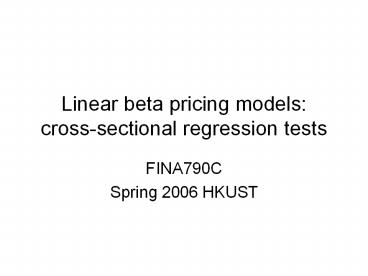Linear beta pricing models: cross-sectional regression tests - PowerPoint PPT Presentation
1 / 19
Title:
Linear beta pricing models: cross-sectional regression tests
Description:
Fama-MacBeth two-pass cross-sectional regression methodology ... So in general the Fama-MacBeth standard errors are incorrect because of the ... – PowerPoint PPT presentation
Number of Views:50
Avg rating:3.0/5.0
Title: Linear beta pricing models: cross-sectional regression tests
1
Linear beta pricing modelscross-sectional
regression tests
- FINA790C
- Spring 2006 HKUST
2
Motivation
- The F test and ML likelihood ratio test are not
without drawbacks - We need T gt N To solve this we could form
portfolios (but this is not without problems) - When the model is rejected we dont know why
(e.g. do expected returns depend on factor
loadings or on characteristics?)
3
Cross-sectional regression
- Can we use the information from the whole
cross-section of stock returns to test linear
beta pricing models? - Fama-MacBeth two-pass cross-sectional regression
methodology - Estimate each assets beta from time-series
regression - Cross-sectional regression of asset returns on
constant, betas (and possibly other
characteristics) - Run cross-sectional regressions each period,
average coefficients over time
4
Linear beta pricing model
- At time t the returns on the N securities are Rt
R1t R2t RNt with variance matrix ?R - Let ft f1t fKt be the vector of time-t
values taken by the K factors with variance
matrix ?f - The linear beta pricing model is ERit ?0
?ßi for i1, ,N or - ERt ?01 B?
- where B E(Rt-E(Rt))(ft-E(ft))?f
5
Return generating process
- From the definition of B the time series for Rt
is - Rt ERt B( ft-E(ft) ) ut
- with Eut 0 and Eutft 0NxK
- Imposing linear beta pricing model gives
- Rt ?01 B(ft-E(ft)?) ut
6
CSR methoddescription
- Define ? ?0 ? ( (K1)x1 vector ) and
- X 1 B ( N x (K1) matrix )
- Assume N gt K and rank(X) K1
- Then ERt 1 B ?0 ? X ?
7
CSR first pass
- In first step we estimate ?f and B through usual
estimators - ?f (1/T)?(ftµf)(ftµf)
- µf (1/T) ?ft
- B (1/T)?(RtµR)(ftµf)?f-1
- µR (1/T) ?Rt
- In practice we can use rolling estimation period
prior to testing period
8
CSR - second pass
- In second step, for each t 1, , T we use the
estimate B of the beta matrix and do
cross-sectional regression of returns on
estimated B - ? (XQX)1XQRt (for feasible GLS with
- weighting matrix Q)
- where X 1 B
- The time-series average is
- ? (1/T)?(XQX)1XQRt
- (XQX)1XQ µR
9
Fama-MacBeth OLS
- Fama-MacBeth set Q IN and
- ?OLS (XX)1XRt
- The time-series average is
- ?OLS (XX)1XµR
- And the variance of ?OLS is given by
- (1/T) ? (?OLS - ?OLS )(?OLS - ?OLS )
10
Issues in CSR methodology
- Dont observe true beta B, but measured B with
error what is effect on sampling distribution of
estimates? - How is CSR methodology related to maximum
likelihood methodology?
11
Sampling distribution of ?
- Let D (XQX)-1XQ, X 1 B
- Basic Result If (Rt, ft) is stationary and
serially independent then under standard
assumptions, as T?8, vT(? - ?) converges in
distribution to a multivariate normal with mean
zero and covariance - V D?RD D?D - D(G G)D
12
Where does V come from?
- Write µR X? (µR - E(Rt)) (B-B)?
- So vT( ? - ?)
- (XQX)-1XQ vT(µR - E(Rt))
- - (XQX)-1XQ vT(B - B) ?
- Error in estimating ? comes from
- Using average rather than expected returns
- Using estimated rather than true betas
13
Comparing V to Fama-MacBeth variance estimator
- From the definition of ?OLS its asymptotic
variance is - (XX) -1X?RX(XX)-1 D?RD
- So in general the Fama-MacBeth standard errors
are incorrect because of the errors-in-variables
problem
14
Special case conditional homoscedasticity of
residuals given factors
- Suppose we also assume that conditional on values
of the factors ft, the time-series regression
residuals ut have zero expectation, constant
covariance ?U and are serially uncorrelated - This will hold if (Rt, ft) is iid and jointly
multivariate normal
15
Asymptotic variance for special case
- Recall ? ?0 ? ( (K1)x1 vector ) and define
the (K1)x(K1) bordered matrix - ?f 0 0K
- 0K ?f
- Then Basic Result holds with
- V ?f (1 ??f-1?)D?UD
- Asymptotically valid standard errors are
obtained by substituting consistent extimates for
the various parameters
16
Example Sharpe-Lintner-Black CAPM
- For k1, this simplifies to
- The usual Fama-MacBeth variance estimator
(ignoring estimation error in betas) understates
the correct variance except under the null
hypothesis that ?1 (market risk premium) 0
17
Maximum likelihood and two-pass CSR
- MLE estimates B and ? simultaneously and thereby
solves the errors-in-variables problem. - Asymptotic covariance matrix of the two-pass
cross-sectional regression GLS estimator ? is
the same as that for MLE - I.e. two-pass GLS is consistent and
asymptotically efficient as T?8
18
Two-pass GLS
- For given T, as N ?8 however, the two-pass GLS
estimator still suffers from an
errors-in-variables problem from using B (i.e.
two-pass GLS is not N-consistent) - We can make the two-pass GLS estimator
N-consistent as well through a simple
modification (see Litzenberger and Ramaswamy
(1979), Shanken (1992))
19
Modified two-pass CSR
- For example Sharpe-Lintner-Black CAPM estimated
with two-pass OLS - The errors-in-variable problem applies to betas,
or the lower right-hand block of XX. Note
that - E(ßß) ßß tr(?U)/(TsM2)
- So deduct the last term from the lower-right hand
block this adjustment corrects for the EIV
problem as N ?8.































